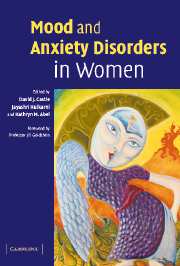Book contents
- Frontmatter
- Contents
- Contributors
- Preface
- Foreword
- 1 Pubertal development and the emergence of the gender gap in mood disorders: A developmental and evolutionary synthesis
- 2 Borderline personality disorder: Sex differences
- 3 Substance use and abuse in women
- 4 Anxiety disorders in women
- 5 Posttraumatic stress disorder in women
- 6 Domestic violence and its impact on mood disorder in women: Implications for mental health workers
- 7 Depression in women: Hormonal influences
- 8 Anxiety and mood disorders in pregnancy and the postpartum period
- 9 Pharmacological treatment of anxiety and depression in pregnancy and lactation
- 10 Bipolar affective disorder: Special issues for women
- 11 Mood and menopause
- 12 Anxiety and depression in women in old age
- Index
3 - Substance use and abuse in women
Published online by Cambridge University Press: 13 August 2009
- Frontmatter
- Contents
- Contributors
- Preface
- Foreword
- 1 Pubertal development and the emergence of the gender gap in mood disorders: A developmental and evolutionary synthesis
- 2 Borderline personality disorder: Sex differences
- 3 Substance use and abuse in women
- 4 Anxiety disorders in women
- 5 Posttraumatic stress disorder in women
- 6 Domestic violence and its impact on mood disorder in women: Implications for mental health workers
- 7 Depression in women: Hormonal influences
- 8 Anxiety and mood disorders in pregnancy and the postpartum period
- 9 Pharmacological treatment of anxiety and depression in pregnancy and lactation
- 10 Bipolar affective disorder: Special issues for women
- 11 Mood and menopause
- 12 Anxiety and depression in women in old age
- Index
Summary
Over the last century, in most Western countries, women have made many great strides in social equality, including winning the right to vote and to equal wages. This chapter describes how and why women may also be gaining ground on their male counterparts in the consumption of alcohol and illicit substances. While women have “come a long way” (a phrase employed in a cigarette advertising campaign in the 1980s) in their drug use, researchers and treatment providers have been slow to identify women's treatment needs, and to develop newer services sensitive to the needs of women with substance abuse or dependence. Thus, we also describe the characteristics of women-sensitive services and recommend that existing services adopt these features. Mostly we concentrate on alcohol abuse and dependence, as alcohol is the substance that has been most well studied in terms of gender differences; many of the general findings extrapolate to other drugs. We do not explicitly address nicotine dependence here.
Epidemiology and clinical issues
Epidemiology of substance use and abuse: gender differences
Surveys of substance abuse and dependence in the general population fairly consistently show overall rates in females to be lower than those in males. For example, the United States (US) Epidemiological Catchment Area (ECA) Study (Helzer et al., 1991) reported an overall rate for alcohol abuse and dependence of 13.6%, with a male:female ratio of around 5:1 (males 23.8%, females 4.6%).
Keywords
- Type
- Chapter
- Information
- Mood and Anxiety Disorders in Women , pp. 39 - 58Publisher: Cambridge University PressPrint publication year: 2006
Accessibility information
- 1
- Cited by

